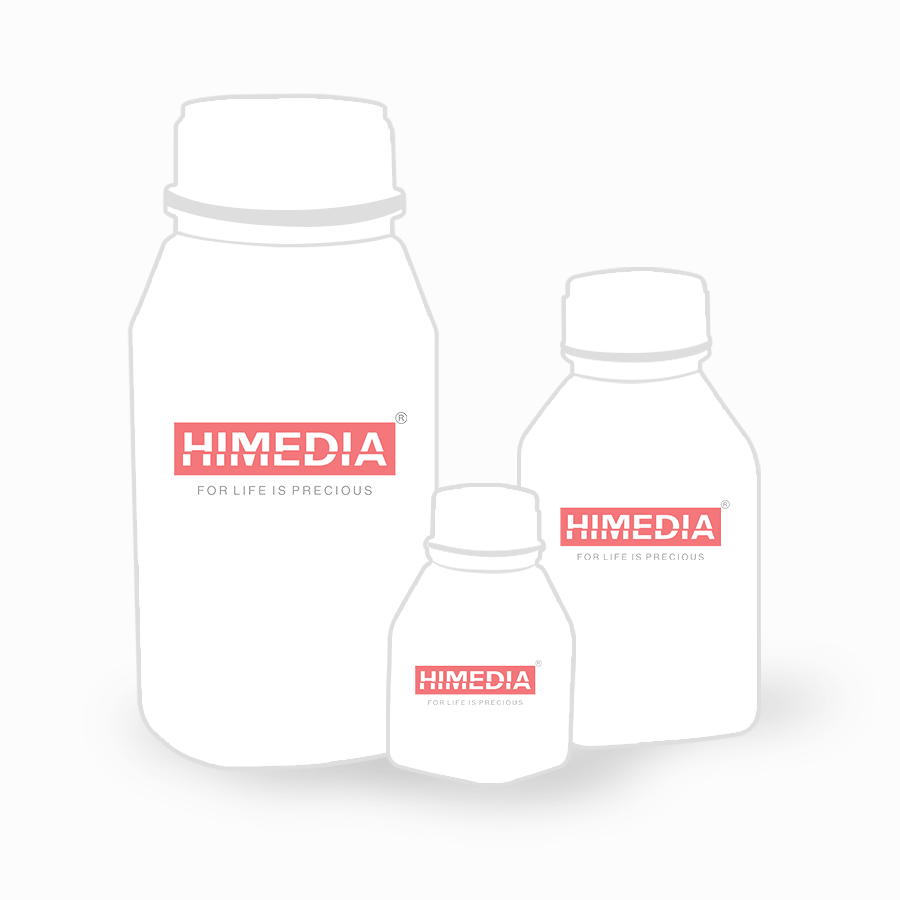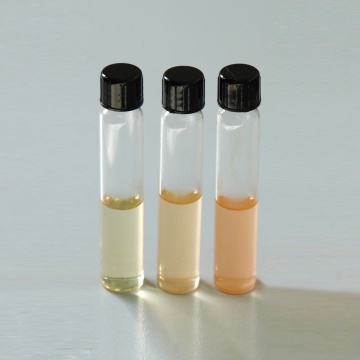 Your enquiry has been submitted
Your enquiry has been submitted
Selenite F Broth (Twin Pack)
Recommended is used as an enrichment medium for isolation of Shigella from food samples. It is recommended by BIS Committee under the specifications IS 5887 (Part III) -1999.
Composition**
| Ingredients | Gms / Litre |
|---|---|
| Part A | |
| Peptone | 5.000 |
| Lactose | 4.000 |
| Sodium dihydrogen phosphate | 0.500 |
| Disodium hydrogen phosphate | 9.500 |
| Part B | |
| Sodium acid selenite(Sodium hydrogen selenite) | 4.000 |
Final pH (at 25°C): 7.1±0.2
**Formula adjusted, standardized to suit performance parameters
Directions
Suspend 4.0 grams of Part B in 1000 ml distilled water. Add 19.0 grams of Part A. Mix well. Warm to dissolve the medium completely. Distribute in sterile test tubes. Sterilize in a boiling water bath or free flowing steam for 30 minutes. DO NOT AUTOCLAVE. Excessive heating is detrimental. Discard the prepared medium if large amount of selenite is reduced (indicated by red precipitate at the bottom of tube / bottle).
Caution: Sodium hydrogen selenite (Sodium bi-selenite) is very toxic, corrosive agent and causes teratogenicity. Handle with great care. Upon contact with skin, wash immediately with a lot of water.
Principle And Interpretation
Selective inhibitory effects of selenite were first demonstrated by Klett (1). Guth (2) used it to isolate Salmonella Typhi. Leifson studied selenite and formulated a medium using selenite. Fluid Selenite Cystine Medium is a modification of Leifsons (3) formula with added cystine (4). The formulation corresponds to that recommended by AOAC (5) for the detection of Salmonella in foodstuff, particularly egg products. It is also recommended by APHA (6, 7) and USP (8). This medium is recommended by ISO Committee (11) and BIS (12). Selenite Cystine Broth is useful for detecting Salmonella in the non-acute stages of illness when organisms occur in the faeces in low numbers and for epidemiological studies to enhance the detection of low numbers of organisms from asymptomatic or convalescent patients (9). Salmonella are also injured during various food processing procedures, including exposure to low temperatures, sub-marginal heat, drying, radiation, preservatives or sanitizers. Recovery of Salmonella involves pre-enrichment, selective enrichment and selective plating since Salmonella may be present in low numbers in food sample in a injured conditions. Fluid Selenite Cystine Medium is used as selective enrichment medium for the cultivation of Salmonella species. This medium is formulated to allow the proliferation of Salmonella while inhibiting the growth of competing non-Salmonella organisms.
Casein enzymic hydrolysate provides nitrogenous substances. Lactose is the fermentable carbohydrate and maintains the pH in medium as selenite is reduced by bacterial growth and alkali is produced. An increase in pH lessens the toxicity of the selenite and results in overgrowth of other bacteria. The acid produced by bacteria due to lactose fermentation serves to maintain a neutral pH. Phosphate maintains a stable pH and also lessens the toxicity of selenite. L-cystine is the reducing agent, improving the recovery of Salmonella. Enriched broth is subcultured on solid medium. Do not incubate the broth longer than 24 hours as inhibitory effect of selenite reduces after 6-12 hours of incubation (10).
Inoculate the food sample into recommended pre-enrichment broth, and then transfer 1 ml of mixture to 10 ml of Fluid Selenite Cystine Medium and also to 10 ml Tetrathionate Broth (M032). Incubate and subsequently subculture on to Bismuth Sulphite Agar (M027), Xylose-Lysine-Deoxycholate Agar (M031), Hektoen Enteric Agar (M467) or MacConkey Agar (M081).
Quality Control
Appearance of Part A
Part A: Cream to yellow homogeneous free flowing powder
Appearance of Part B
Part B: White to cream homogeneous free flowing powder
Colour and Clarity of prepared medium
Light yellow coloured, clear to slightly opalescent solution of complete medium
Reaction
Reaction of medium [(1.9% w/v) Part A and (0.4% w/v) Part B] at 25°C. pH : 7.1±0.2
pH
6.90-7.30
Cultural Response
Cultural characteristics observed after an incubation at 35-37°C for 18-24 hours when sub cultured on MacConkey Agar (M081).
| Organism | Inoculum (CFU) | Recovery | Colour of Colony |
|---|---|---|---|
| Escherichia coli ATCC 25922 | 50-100 | little-none(no increase in numbers) | pink with bile precipitate |
| Salmonella Choleraesuis ATCC 12011 | 50-100 | luxuriant | colourless |
| Salmonella Typhimurium ATCC 14028 | 50-100 | luxuriant | colourless |
| Salmonella Typhi ATCC 6539 | 50-100 | luxuriant | colourless |
| Escherichia coli NCTC 9002 | 50-100 | little-none (no increase in numbers) | pink with bile precipitate |
| Escherichia coli ATCC 8739 | 50-100 | little-none (no increase in numbers) | pink with bile precipitate |
| Shigella flexneri ATCC 12022 | 50-100 | Good | colourless |
| Shigella sonneii ATCC 29930 | 50-100 | Good | colourless |
Storage and Shelf Life
Store below 30°C in a tightly closed container and the prepared medium at 2 - 8°C. Use before expiry date on the label.
Reference
- Klett A., 1900, Zeitsch Fer Hyg. Und. Infekt., 33: 137.
- Guth F., 1916, Zbl. Bakt. I. Orig., 77:487.
- Leifson E., 1936, Am. J. Hyg., 24(2): 423.
- North W. R. and Bartram M. T., 1953, Appl. Microbiol., 1:130.
- FDA Bacteriological Analytical Manual, 2005, 18th Ed., AOAC, Washington, DC.
- Downes F. P. and Ito K., (Eds.), 2001, Compendium of Methods for the Microbiological Examination of Foods, 4th Ed., APHA, Washington, D.C.
- Wehr H. M. and Frank J. H., 2004, Standard Methods for the Microbiological Examination of Dairy Products, 17th Ed., APHA Inc., Washington, D.C.
- The United States Pharmacopeia, 2006, USP29/NF24, The United States Pharmacopeial Convention, Rockville, M. D.
- Murray P. R., Baron E. J., Jorgensen J. H., Pfaller M. A., Yolken R. H., (Eds.), 8th Ed., 2003, Manual of Clinical Microbiology, ASM, Washington, D.C.
- Chattopadhyay W. and Pilford J. N., 1976, Med. Lab. Sci., 33:191.11. Hartman P. A. and S. A., Munich, 1981, J. Food Pract., 44: 385-386
- International Organization for Standardization (ISO), 1993 Draft ISO/DIS 6579.
- Bureau of Indian Standards, IS :5887, (Part 3) 1999.
Disclaimer:
User must ensure suitability of the product(s) in their application prior to use. Products conform solely to the information contained in this and other related HiMedia™ publications. The information contained in this publication is based on our research and development work and is to the best of our knowledge true and accurate. HiMedia™ Laboratories Pvt Ltd reserves the right to make changes to specifications and information related to the products at any time. Products are not intended for human or animal or therapeutic use but for laboratory, diagnostic, research or further manufacturing use only, unless otherwise specified. Statements contained herein should not be considered as a warranty of any kind, expressed or implied, and no liability is accepted for infringement of any patents.
| Product Name | Selenite F Broth (Twin Pack) |
|---|---|
| SKU | M025S |
| Product Type | Regular |
| Physical Form | Powder |
| Origin | Animal |
| Packaging type | HDPE |
| References | 1. Klett A., 1900, Zeitsch Fer Hyg. Und. Infekt., 33: 137. 2.Guth F., 1916, Zbl. Bakt. I. Orig., 77:487. 3.Leifson E., 1936, Am. J. Hyg., 24(2): 423. 4.North W. R. and Bartram M. T., 1953, Appl. Microbiol., 1:130. 5.FDA Bacteriological Analytical Manual, 2005, 18th Ed., AOAC, Washington, DC. 6.Salfinger Y., and Tortorello M.L. Fifth (Ed.), 2015, Compendium of Methods for the Microbiological Examination ofFoods, 5th Ed.,APHA, Washington, D.C. 7.Wehr H. M. and Frank J. H., 2004, Standard Methods for the Microbiological Examination of Dairy Products, 17th Ed.,APHA Inc., Washington, D.C. 8.The United States Pharmacopeia, 2017, USP29/NF24, The United States Pharmacopeial Convention, Rockville, M. D. 9.Murray P. R., Baron E. J., Jorgensen J. H., Pfaller M. A., Yolken R. H., (Eds.), 8th Ed., 2003, Manual of ClinicalMicrobiology, ASM, Washington, D.C. 10.Chattopadhyay W. and Pilford J. N., 1976, Med. Lab. Sci., 33:191. 11. Hartman P. A. and S. A., Munich, 1981, J. FoodPract., 44: 385-386 12.Isenberg, H.D. Clinical Microbiology Procedures Handbook. 2nd Edition.1 3.Jorgensen,J.H., Pfaller , M.A., Carroll, K.C., Funke, G., Landry, M.L., Richter, S.S and Warnock., D.W. (2015)Manual of Clinical Microbiology, 11th Edition. Vol. 1. |
| Customized Product Available | No |








